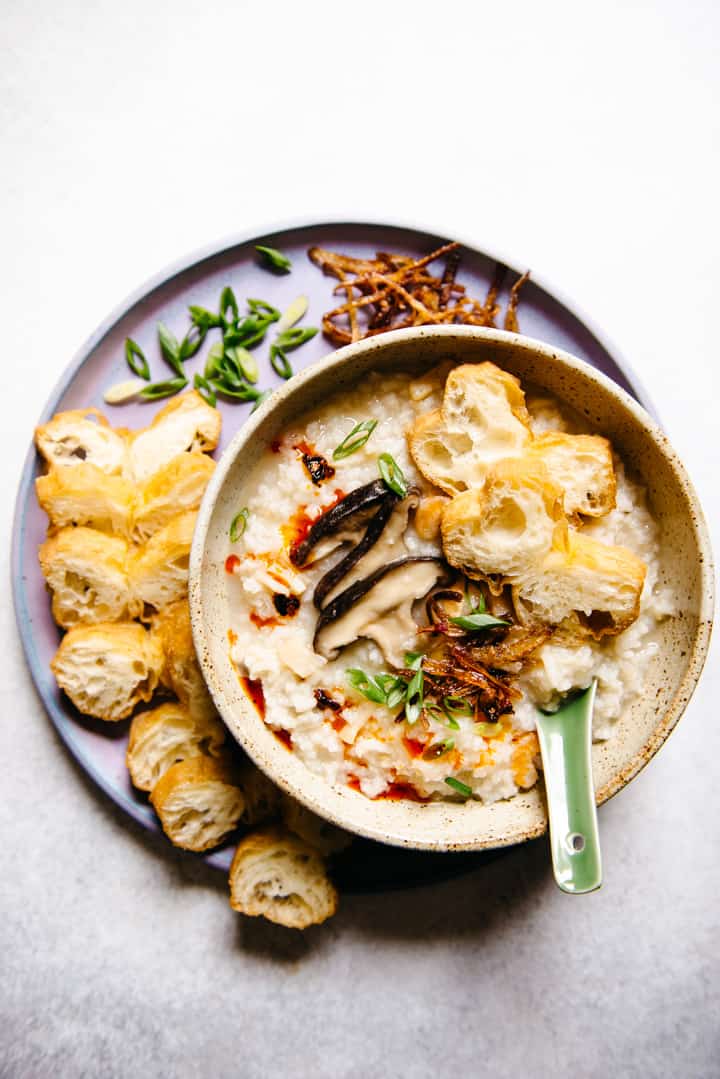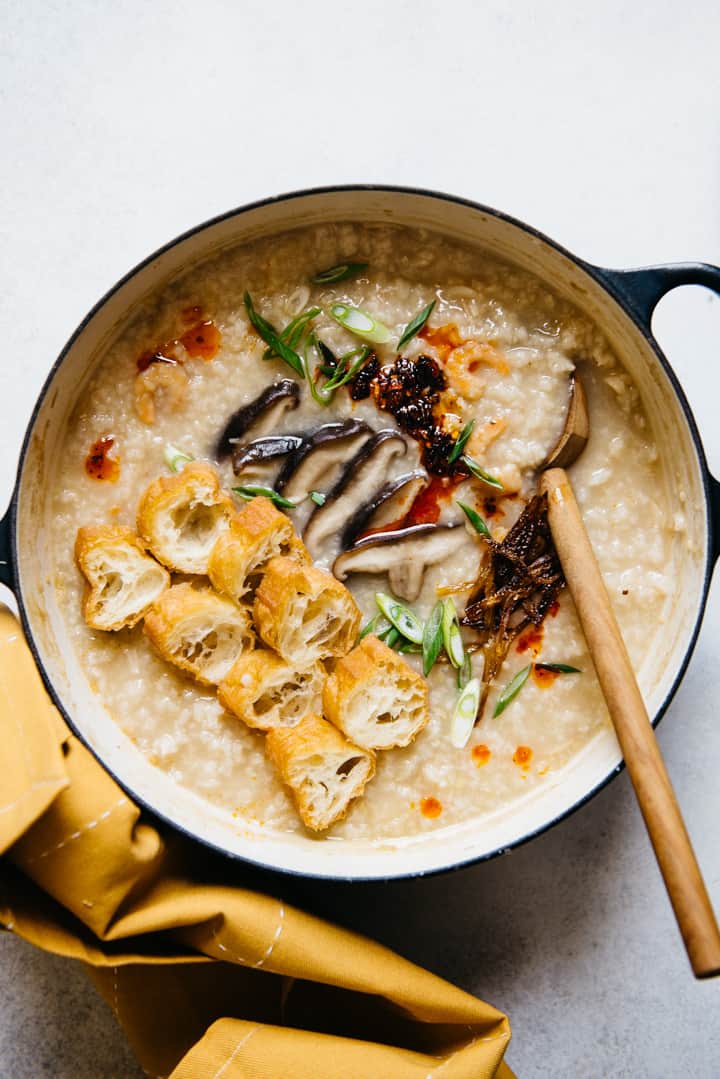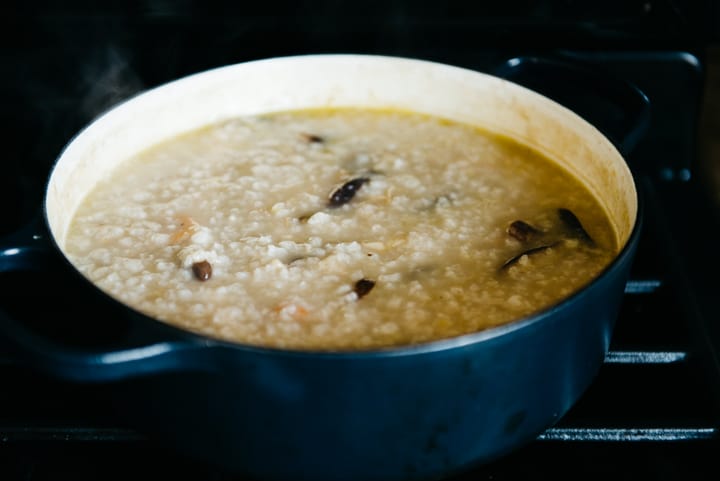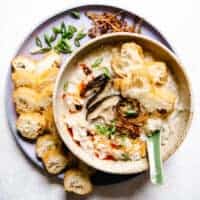
WHAT IS CONGEE/JOOK?
Congee is the ultimate comfort food in Asian cuisine. The word “congee” derives from Tamil, and different Asian cultures have their own version of this delectable, often savory, rice porridge.
In Chinese cooking, congee (粥, pronounced jook in Cantonese or zhou1 in Mandarin) usually involves boiling jasmine rice with a lot of water over low heat. You’ll often see people cook the rice along with ingredients that impart umami flavor, such as dried seafood or pork bones.
You can serve congee at any time of the day. When I was young, Mama Lin often cooked congee for breakfast on the weekend, and we’d eat leftovers for lunch or dinner. Whenever I was sick, Mama Lin would also make a simple congee for me because it is easy to digest.
There are many variations of congee in Chinese cuisine, such as 皮蛋瘦肉粥 (congee with century egg and lean pork) or 魚片粥 (congee with sliced fish). In my basic congee recipe, I’m only using ginger, garlic, dried shrimp, dried scallops, and shiitake mushrooms for flavoring. Because I grew up on congee cooked with dried seafood, I tend to prefer congee with those flavors.

CONGEE RECIPE: RICE-TO-LIQUID RATIO
I would be lying if I told you that Mama Lin follows a specific congee recipe. She always seems to figure out a magical rice-to-water ratio whenever she makes it.
After cooking congee numerous times on my own, I figured out that I prefer a 1-to-9 rice to liquid ratio: 1 cup of jasmine rice to 9 cups liquid (can be water, broth, or a mixture of both). The congee is neither too watery nor too thick. You can play with the amount of water or broth you use to determine what works best for you.
Keep in mind that rice continues to absorb liquid even after it’s cooked. Don’t worry if you think you’ve started out with too much water. You can always boil down the congee with the pot uncovered or let the cooked congee sit at room temperature for 15 to 20 minutes.
DO YOU NEED TO SOAK THE RICE BEFORE COOKING?
No, you don’t. Jasmine rice breaks down quite easily, so there is no need to presoak the grains.
HOW TO MAKE CONGEE AHEAD
You can make this congee recipe up to 1 or 2 days ahead and store it in the fridge. You’ll notice that the porridge thickens the next day. Give everything a stir and reheat the congee in a microwave or saucepan with a splash of water.

WHAT TO SERVE WITH CONGEE
Congee is often served with fresh scallions, cilantro, soy sauce, or fish sauce. You might also see people add fried shallots or chili oil, like I’ve done in the photos.
In Chinese restaurants, you’ll almost always see congee served with fried dough sticks that are crunchy on the outside and spongy on the inside. Mandarin-speaking regions often call the fried dough 油條, which roughly translates to oil sticks. Cantonese-speaking regions call it 油炸鬼, which literally means oil fried ghosts—no idea where that phrase comes from.
I usually buy the fried dough frozen at Asian supermarkets. There is no need to defrost them before reheating. Just bake it on a pan for 5 minutes at 375ºF (190ºC) for 5 minutes. Then, turn off the heat but leave the fried dough sticks in the oven. The residual heat will continue to crisp up the fried dough.
MORE PORRIDGE RECIPES
If you are interested in another porridge recipe, try my vegan congee recipe! It uses shiitake mushrooms, lemongrass, and ginger for flavor. I also have a kabocha congee, which uses kabocha purée to naturally sweet the porridge.
Basic Congee (Jook, 粥, Chinese Rice Porrdige)
Ingredients
Congee
- 1/4 cup dried shrimp
- 2 tablespoons dried scallops
- 2 tablespoons safflower oil, any oil works
- 2 tablespoons minced ginger
- 3 cloves garlic, minced
- 1/4 pound shiitake mushrooms, sliced into 1/4-inch thickness
- 1 cup jasmine rice
- 6 cups vegetable broth
- 3 cups water
- 1 teaspoon salt, add more to taste
To Serve
- sliced scallions
- fried shallots
- fried dough sticks (油條/油炸鬼)
- chili oil
Instructions
- Rinse the dried shrimp and dried scallops with water. Then, place them in a bowl and soak with 2/3 cup of water for 30 minutes. The shrimp and scallops should have plumped up a little. You can drain the water once you’re done soaking or save it. I usually save the water and use it to cook the porridge.
- Rinse the rice once and drain the water.
- Heat the oil in a pot over medium-high heat. Add the minced ginger and garlic and cook for 30 seconds, until they start to become fragrant. Add the rehydrated shrimp and scallops to the pot. Use the tip of a wooden spoon or spatula to break the scallops apart. This does not need to be too precise. Add the mushrooms and rice, and sauté for another minute.
- Carefully pour the broth and water into the pot. Sprinkle in the salt and stir. Bring the broth to a boil, uncovered. Then, turn the heat to low and cover the pot. I usually transfer the pot to a smaller burner so the congee cooks at very low heat. Let the congee simmer for about an hour, stirring occasionally.
- After an hour, check the congee to see if the consistency is to your liking. I like to leave the pot uncovered for 15 minutes so that the porridge cools and thickens. If you notice a small film form on the top of the congee, just stir everything before serving. Taste the congee and add more salt if necessary.
- Serve the congee in bowls. Have sliced scallions, fried shallots, chili oil, and sliced fried dough sticks on the side for topping.



Ang Avi says
As I remember, during the Song Dynasty, three outstanding military men were framed and wrongfully accused of treason/rebellion by a couple from the court. The innocent men were detained and killed over that false accusation.
The people of Lin’an City were so upset about it, that they made two stick figures of dough pressed together and fried them in hot oil, representing the couple and how they would “fry” in hell/afterlife.
These fritters became so popular that, in order to make production more efficient, they started using the simpler two sticks of dough pressed together we now know and started calling them “fried oysters” for the resemblance of the resulting product.
Due to the language barrier between different regions and dialects,
they started calling them fried ghost in Suzhou. Since the court had already heard about the “fried oysters”, civilians kept calling them “fried ghosts” to avoid problems with the authorities.
And that is the story of Chinese crullers.
Jeaux says
How interesting!
J says
The consistency of the congee was perfect as mentioned the rice to liquid ratio. I’ve made it twice already with little changes here and there depending on what ingredients I had in the fridge, but each time has turned out delicious. Thank you for the recipe and tips!
Enid Coleslaw says
Excellent recipe! I used to be lazy and make my porridge in the rice cooker, but that meant missing out on sautéing the aromatics and rice. The dried scallops and prawns are essential too…they make all the difference flavour-wise. I got away with about 5 cups of water/broth and 45 mins of cooking and it was still good. Thanks!
Wilfred Mah says
I thought this Congee recipe was very good and easy to make .
Instead of using safflower oil , I used 11/4 teaspoon sesame
oil . I found the sesame oil gave the congee a really good flavour .
Lisa Lin says
Thanks for the feedback, Wilfred!
Orla says
Have made this a few times not and we love it.
Lisa Lin says
Thank you, Orla!
Kathryn Levy says
Made this a few modifications because of fridge resources but it turned out perfectly. Thanks for the post!
Lisa Lin says
Glad you enjoyed it, Kathryn! Thanks for making it.
Michelle says
I try to cook it one time but some ingredients I skip and choose only the ing. that my boss and family like and they like it😍 now every Friday I cook it for are dinner….
newtocongee says
I used this recipe for my first time making congee- even my first time eating it! It’s delicious, though I made it without scallops because I didn’t have any on hand.
Dee says
Is jasmine rice the best type for congee? Could you use other types of rice like basmati?
Rose marie says
made it today used 6 cups chicken stock, 4 chicken boillion, 3 8 oz water bottle, taste pretty good. I wanted the congee plain but served w/ shredded chicken, toasted garlic slices, scallions, slices sitakee mushrooms, cilantro fried wonton wrapper cut in 4 small squares cooked low heat 2 hours,
Richard Young says
I am from Hawaii,and my mother-made it different ways. Using dried scallops and shrimp-is a new one on me. You can use different types of rice-from short and long grain. My father-on his way from home-would pick up fish cake-and spoon it in. Never add the salt in the begging. Add kosher-or sea salt. In Korea-they make it different. Growing up- I like to stir in chopped head lettuce.
Tracey Cheung says
How do you make it add pinced pork in it?
Like when would you add it?
Melisa says
I know that this isn’t relevant to the recipe but I just wanted to inform that 粥 is zhou not jook and it’s pronounced kinda like the name Joe. There’s nothing that’s written like jook as far as I’m aware. 😉
Lisa Lin says
Hi, Melisa. “Zhou” (first tone) is the Mandarin pronunciation. As I mentioned in the post, “jook” is the Cantonese pronunciation, which is predominantly spoken in Guangdong, Hong Kong, and among the Chinese diaspora all over the world. There are many dialects in the Chinese language, and I speak three of them. Perhaps you were only looking at sources that referred only to the Mandarin pronunciation.
ZETT says
*MIC DROP*
Karen De Witt says
Loved your recipe. The first time I saw this is in Full Kee, a terrific Chinese restaurant in DC, that I stumbled on when I had a break from jury duty. Packed, steamed up window hung with ducks, not a white face, or black one (until I entered) in the restaurant. I saw it and thought it was like cream of wheat or cream of rice and didn’t realize that it was savory. Ahhh, the moment of discovery was with some Australian friends who’d been in the diplomatic service in China. I’ve made your recipe with leftover shrimp, leftover salmon, leftover pork, sesame seed oil, chicken stock, lots of garlic and finished it with some oyster sauce and a dash of fish stock. Eaten with chili oil, spring onions and fried garlic. Yum. May become my new go-to recipe. Thank you
Leah says
This recipe is delicious! I was looking for a basic congee and stumbled on this one. I didn’t have the dried shrimp or scallops on hand and it still turned out great.
Lisa Lin says
Thanks, Leah!
Shirley says
I haven’t made this yet but I’m really looking forward to trying it. I remember jook when I lived in Vancouver, BC. My ex-mother in law used to make it after roasting a turkey. It was so savory and delicious. And of course, I would enjoy it at dim sum occasionally, when it was available. Good food memories.
Karman Foods says
Congee is one of my favorite food whenever I feel unwell or even when it’s raining. I usually add Momo Dressing Yuzu Ponzu Sauce to add a delicious citrusy taste to it.
Chow says
I’ve made this starting with frozen meatballs( not Italian type) very delicious
Lisa Lin says
Good to know! Thanks, Chow!
Mike says
My kids and I made this. Simple and super flavorful. They left me all the mushrooms but I don’t mind. We used a bag of ready to use frozen shrimp and added them about 20 minutes left when we pulled the lid and simmered to thicken. Excellent and leftovers good for days. Thank you so much!
Dana Chiu says
I made this today for first time. It was delicious! Thank you for a great recipe. I will definitely make again.
Lisa Lin says
Thanks, Dana!!
Den says
I am going to make this but I am wondering why your vegan recipe says to remove mushrooms before serving and this recipe does not.
Also, if I want to add chicken, when do I put it in?
Thank you!
Lisa Lin says
Oh, it’s because I used dried shiitake mushrooms in the vegan recipe, and I don’t like eating that as much as fresh mushrooms. This recipe uses fresh mushrooms. If you want to add chicken, add it when you being to boil the congee!
Cass says
this is Umami bomb! I can’t believe I managed to cook a yummy bowl of congee 🙂 Thank you for your recipe, this is a definite keeper. I added some Sarawak White pepper and sesame seed oil as this is how we like it in Malaysia.
Lisa Lin says
Thanks for making this recipe, Cass! Glad you enjoyed it!!
Lynn A. says
Hi Lisa,
I have never made Congee, and my question to myself is “Why?”. It was so savory, satisfying and a comfort food. I followed your recipe exactly, and even found the fried dough. I used broken jasmine rice. I will definitely make it again and again. Thank you for sharing your recipe.
Lisa Lin says
Thank you so much for trying this recipe, Lynn!!
Alex says
Is the rice cooked separately or together. Other than washing the rice, I’m not seeing what to do with it.
Lisa Lin says
You add it to the pot like it says in step 2.
Maria Beard says
I discovered congee on the Norwegian cruise we just took this month. It was on the breakfast buffet,near other unique ethnic foods(Marsala,tandoori fish, eggplant and okra dishes). We soon came to prefer taking most of our meals here(as did many of the crew from the cruise in uniform). The chefs were amazing..as were the staff members who told me their family recipes for congee.